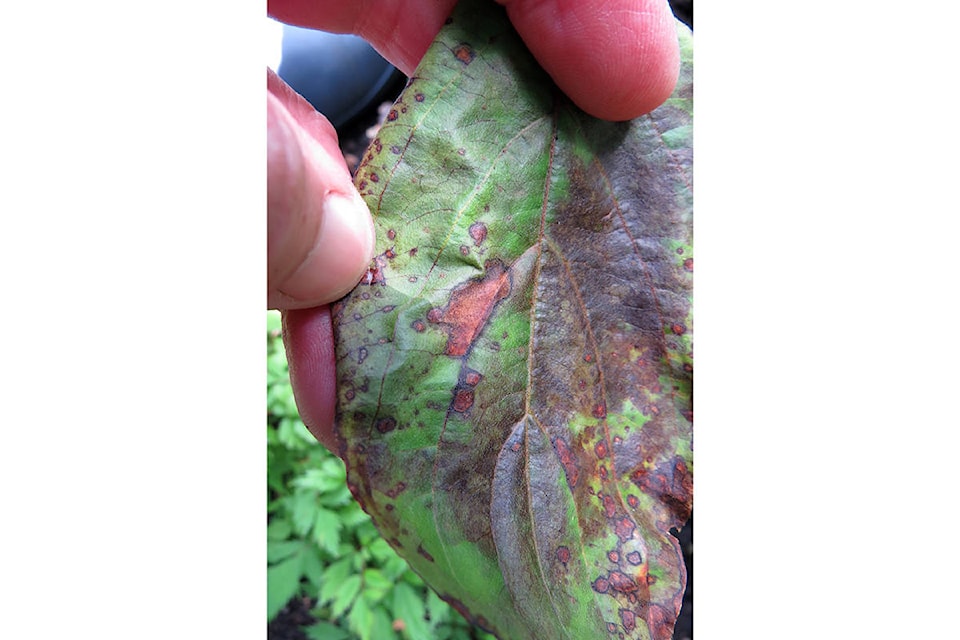Leslie Cox
Special to The Record
Wouldn’t you know it? One of the most spectacular dogwood trees in full bloom I have ever seen and me without my camera. Murphy’s Law bit me in the butt once again. But what a thing of beauty, that tree. I felt blessed just for having seen the 30-odd feet of floral wonder as brief as it was as we drove by. But it also made me mourn the demise of my dogwood tree all over again.
I am fond of dogwoods and planted a native one, Cornus nuttallii or Pacific dogwood, in the front garden years ago. Slow growing, it never bloomed until one spring, seven years after I had put the tree in the ground, with John’s help, mind… I shook my fist at it and said, “Bloom, damn it, or I am ripping you out!” Must have scared the tree half out of its wits because that very year it gave me a few blooms. And repeated its display reliably every year after. But then disaster struck.
Spring of 2014 my dogwood started dropping a few leaves. I first thought it was being starved of water, having to fight for moisture the chestnut tree might have missed. But I quickly discovered the problem was not water deficiency but fungus related. My dogwood had picked up dogwood anthracnose…also called Discula destructiva. Where the heck?
No one knows for sure where this fungus came from…what part of the globe… but it definitely was diagnosed on a few flowering dogwood trees, Cornus florida, in both Seattle and New York in 1976 and 1978 respectively. In B.C., dogwood anthracnose was positively identified on flowering dogwoods in 1983 and on the same tree species in Ontario in 1998. Somewhere in that time frame, the anthracnose spread to the Pacific dogwood.
It really is a devastating disease. Diagnosis is confirmed by small, light brown spots…first appearing on the lower leaves of an infected tree, and then traveling up the tree. These spots often merge to form large, irregular lesions. A reddish-purple-coloured border around the spots and lesions is another identifying feature. And sometimes, the tan centre of a spot will disintegrate, leaving just the purple-coloured circle as a diagnostic clue.
But the fungus does not stop at the leaves. It spreads to the buds and fruits, as well as the smaller branches where it forms oval-shaped cankers that enlarge until they girdle the branch, effectively killing it.
From the small branches, this fungus normally spreads to larger branches and the trunk of the tree. At that extended point of infection, the demise of the tree is pretty much assured over time. But I did not let my tree get that far along. With no known cure and faced with eventual death, we cut my tree down and removed the roots. Serves me right for shaking my fist and yelling at it.
Apparently, Cornus kousa or white-flowered Kousa dogwoods are less likely to succumb to the anthracnose. And plant hybridizers have also produced a cross between C. kousa and C. florida as well as a number of beautifully named cultivars. The beautiful tree we whizzed past the other day was likely one of these. It certainly was the picture of health.
Earlier I mentioned “missed photo ops”…as in plural. Really, really wish I had my camera when I spied Sadie confronting a garter snake by the pond. She was showing off perfect Golden Retriever hunting stance, eyes glued on the snake who was sun-bathing on a piece of driftwood. The snake had its head raised as if to strike and calmly flicked its tongue at her. Snake must have known Sadie is trained not to step in the garden beds and he was out of her reach.
Leslie Cox co-owns Growing Concern Cottage Garden in Black Creek. Her website is at www.duchessofdirt.ca
